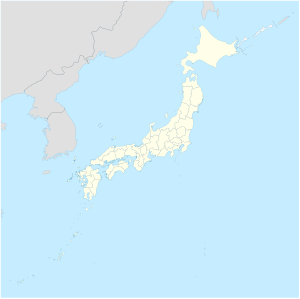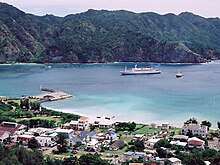Ogasawara (Tokyo)
| Ogasawara-mura 小 笠原 村 |
||
|---|---|---|
|
|
||
| Geographical location in Japan | ||
| Region : | Kanto | |
| Prefecture : | Tokyo | |
| Coordinates : | 27 ° 6 ' N , 142 ° 12' E | |
| Basic data | ||
| Surface: | 104.41 km² | |
| Residents : | 3047 (October 1, 2019) |
|
| Population density : | 29 inhabitants per km² | |
| Community key : | 13421-0 | |
| Symbols | ||
| Flag / coat of arms: | ||
| Tree : | Pandanus boninensis | |
| Flower : | Schima wallichii | |
| Bird : | Bonin honeyeater | |
| town hall | ||
| Address : |
Ogasawara Village Hall Aza Nishi-machi, Chichi-jima Ogasawara -mura Tōkyō 100-2101 |
|
| Website URL: | www.vill.ogasawara.tokyo.jp | |
| Location of Ogasawaras in Tokyo Prefecture | ||
Ogasawara ( Jap. 小笠原村 , - mura ) is a village community in the sub-prefecture Ogasawara , Tokyo Prefecture .
geography
The municipal area includes all of the Ogasawara Islands , with the remote island of Minami-Torishima being the easternmost point and Okinotorishima being the southernmost point of Japan.
The only inhabited islands, Chichi-jima and Haha-jima , are 50 km apart. The City Hall is located on Chichi-jima, 1000 km from Chiyoda , Tokyo . A special feature is that the community does not belong to a district ( gun ), but is directly subordinate to a sub-prefecture of the same name.
On Chichi-jima in 2001 the mean annual temperature was 23.3 ° C with 33.6 ° C as maximum and 10.9 ° C as minimum. The precipitation is about 1600 mm per year.
The soils on Haha-jima are rather moist, so that the trees reach heights of growth of 15 m and in the central Sekimon area ( 石門 ) there is a primeval forest. A nature reserve was established here in 1994 to protect its ecosystem. On the Hahajima island chain, on the other hand, there are rather dry soils with dry bushes that are only 8 m high. Due to the remote location, there are many endemic animal and plant species on the islands. In the case of plants, these account for around 50%. Only on Haha-jima is z. B. the Hahajima Meguro ( Apalopteron familiare hahasima ), which was declared an extraordinary natural monument ( 特別 天然 記念 物 , tokubetsu tennen kinenbutsu ). On Minami-Iwojima even all kinds are a natural monument and the entire island is one of only five "areas for the preservation of the untouched, natural environment" ( 原 生 自然環境 保全 地域 , gensei shizen kankyō hozen chiiki ).
history
In 1593 Ogasawara Sadayori , lord of Fukashi Castle , reported the discovery of the islands. The first settlement took place in 1830 by five whites and twenty Hawaiian emigrants on Chichi-jima. In 1876 the Meiji government sent an expedition to the islands and claimed it for itself. In 1880 the archipelago was administratively assigned to the newly established branch Ogasawara ( 小 笠原 出 張 所 , Ogasawara-shutchōjo ) of the Tokyo Prefecture. In 1882 all foreigners were naturalized. In 1886 the branch was replaced by the island authority Ogasawara ( 小 笠原 島 庁 , Ogasawara-tōchō ) and this in 1926 by the sub-prefecture of Ogasawara. From July 30th to August 1st, 1927, Emperor Hirohito visited the islands.
In 1940 the villages Ōmura ( 大村 ), Ōgimura-Fukurosawa ( 扇 村 袋 沢 村 , -mura ) on Chichi-jima, Okimura ( 沖村 ) and Kitamura ( 北 村 ) on Haha-jima and Iōtō ( 硫黄島 村 , -mura ) on Iwojima (Iōtō) organized as independent communities.
In 1944, due to the worsening war situation, all 6,886 residents except the 825 civilian employees were evacuated to the main islands. The islands were occupied by the United States . In 1946, 129 former residents of European or American background were allowed to return.
On June 26, 1968, the islands were returned to Japan and administratively assigned to a single village Ogasawara within the newly established sub-prefecture. This enabled the Japanese-born residents to return. The exception is Iwojima, which until today (2009) is administered by the marine self-defense forces and whose entry for civilians is essentially only permitted for grave visits.
On October 16, 1972, the Ogasawara National Park was established over the archipelago. From February 2-14, 1994, Emperor Akihito and Empress Michiko paid a visit to the islands.
Attractions
The archipelago is visited for tourism because of its largely untouched nature and biodiversity.
traffic
Prefecture Road 240 is on Chichi-jima and Prefecture Road 241 is on Haha-jima.
Chichi-jima can be reached from the port of Tokyo with the ship Ogasawara-maru ( お が さ わ ら 丸 ) with a journey time of 25½ hours. The Futami port ( 二 見 港 , Futami-kō ) is called. From there, the Hahajima-maru ( は は じ ま 丸 ) runs to Haha-jima with a two-hour journey.
An airport was planned until 1998 on Ani-jima, the uninhabited neighboring island of Chichi-jima, but abandoned for environmental reasons. Then suggested for Chichi-jima himself, but then given up again for the same reasons.
economy
From the Taishō to the early Shōwa period , fruit trees and winter vegetables were grown due to the subtropical climate. Mainly bonito and tuna were fished, but whaling and coral mining were also pursued .
Nowadays the island's inhabitants live mainly from tourism. A specialty of the island is the 40% rum, which is said to go back to Nathaniel Savory from Massachusetts , one of the white first settlers.
education
The community operates the Ogasawara Elementary School and the Ogasawara Middle School on Chichi-jima, and the Haha-jima Elementary School and Haha-jima Middle School on Haha-jima. There is also the Ogasawara high school run by the prefecture on Chichi-jima.
Web links
Individual evidence
- ↑ a b c 自然 (Eng. "Nature"). (No longer available online.) Ogasawara Village, archived from the original on September 23, 2009 ; Retrieved September 14, 2009 (Japanese). Info: The archive link was inserted automatically and has not yet been checked. Please check the original and archive link according to the instructions and then remove this notice.
- ↑ a b c d 沿革 (German "historical development"). Ogasawara Village, accessed July 26, 2016 (Japanese).
- ↑ a b 歴 史 (Eng. "History"). Ogasawara Village, accessed July 26, 2016 (Japanese).
- ↑ 硫黄島 (Eng. "Iōtō"). (No longer available online.) Ogasawara Village, archived from the original on September 16, 2009 ; Retrieved September 14, 2009 (Japanese). Info: The archive link was inserted automatically and has not yet been checked. Please check the original and archive link according to the instructions and then remove this notice.
- ↑ 交通 ア ク セ ス (Eng. "Traffic access"). Ogasawara Village, accessed September 14, 2009 (Japanese).
- ↑ Plan for Chichijima airport withdrawn. Environmental risks for Ogasawara isle are too great, Tokyo report says. The Japan Times, November 14, 2001, accessed June 21, 2009 .
- ↑ 特 産品 紹 介 ( Eng . "Presentation of the regional specialty"). Ogasawara Village, accessed July 26, 2016 (Japanese).
- ↑ 学校 教育 (German "school education"). Ogasawara Village, accessed July 26, 2016 (Japanese).
- ↑ 小 笠原 高等学校 の HP ペ ー ジ . Ogasawara High School, accessed June 22, 2009 (Japanese).




